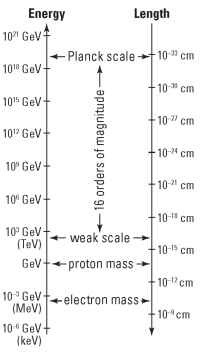The Standard Model of particle physics is an astounding success, but it hasn’t answered every question that physics hands to it. One of the major questions that remains is the hierarchy problem, which seeks an explanation for the diverse values that the Standard Model lets physicists work with. Many physicists feel that string theory will ultimately be successful at resolving the hierarchy problem.
For example, if you count the theoretical Higgs boson (and both types of W bosons), the Standard Model of particle physics has 18 elementary particles. The masses of these particles aren’t predicted by the Standard Model. Physicists had to find these by experiment and plug them into the equations to get everything to work out right.
If you look back at Table 8-1, you notice three families of particles among the fermions, which seems like a lot of unnecessary duplication. If we already have an electron, why does nature need to have a muon that’s 200 times as heavy? Why do we have so many types of quarks?
Beyond that, when you look at the energy scales associated with the quantum field theories of the Standard Model, as shown in Figure 8-5, even more questions may occur to you. Why is there a gap of 16 orders of magnitude (16 zeroes!) between the intensity of the Planck scale energy and the weak scale?

Figure 8-5:
The hierarchy problem in physics relates to the large gap between the weak scale and Planck scale of length and energy.
At the bottom of this scale is the vacuum energy, which is the energy generated by all the strange quantum behavior in empty space — virtual particles exploding into existence and quantum fields fluctuating wildly due to the uncertainty principle.
The hierarchy problem occurs because the fundamental parameters of the Standard Model don’t reveal anything about these scales of energy. Just as physicists have to put the particles and their masses into the theory by hand, so too have they had to construct the energy scales by hand. Fundamental principles of physics don’t tell scientists how to transition smoothly from talking about the weak scale to talking about the Planck scale.
As I explain in topic 2, trying to understand the “gap” between the weak scale and the Planck scale is one of the major motivating factors behind trying to search for a quantum gravity theory in general, and string theory in particular. Many physicists would like a single theory that could be applied at all scales, without the need for renormalization (the mathematical process of removing infinities), or at least to understand what properties of nature determine the rules that work for different scales. Others are perfectly happy with renormalization, which has been a major tool of physics for nearly 40 years and works in virtually every problem that physicists run into.
